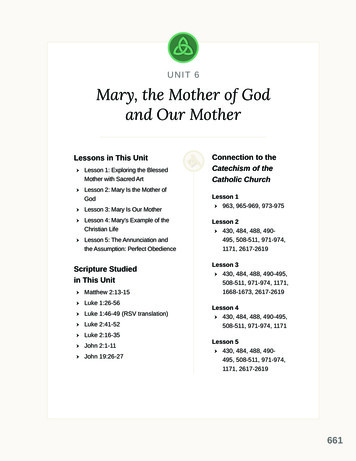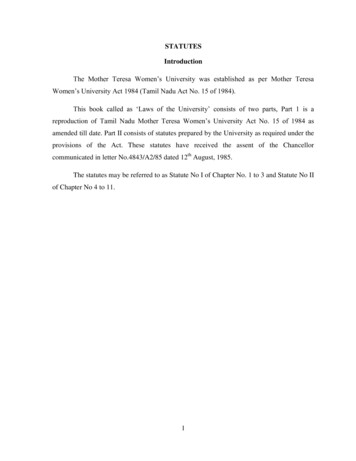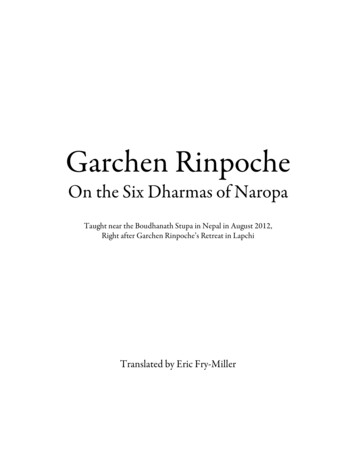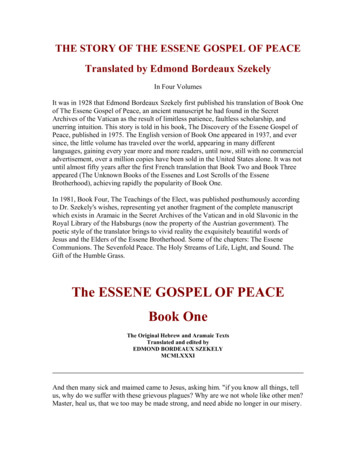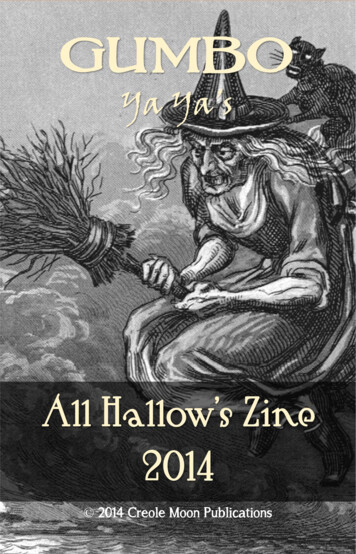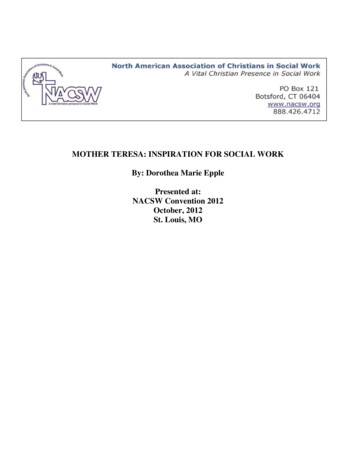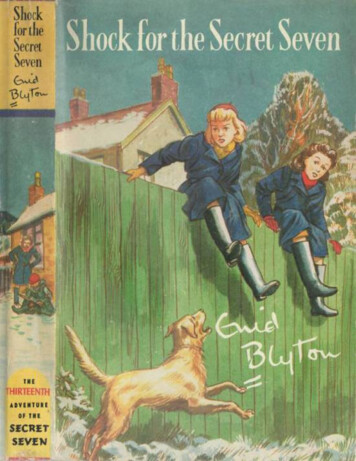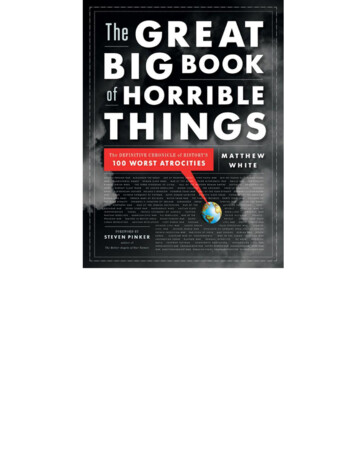
Transcription
To my mother, who gave me my sense of humor,and my father, who gave me my sense of justice
CONTENTSList of MapsForeword by Steven PinkerIntroductionSecond Persian WarAlexander the GreatAge of Warring StatesFirst Punic WarQin Shi Huang DiSecond Punic WarGladiatorial GamesRoman Slave WarsWar of the AlliesThird Mithridatic WarGallic WarAncient InnumeracyXin DynastyRoman-Jewish WarsThe Three Kingdoms of ChinaFall of the Western Roman EmpireJustinianGoguryeo-Sui WarsMideast Slave TradeAn Lushan RebellionMayan CollapseThe CrusadesReligious KillingFang La RebellionGenghis KhanAlbigensian CrusadeHulagu’s InvasionHundred Years WarFall of the Yuan DynastyBahmani-Vijayanagara WarTimurChinese Conquest of VietnamAztec Human SacrificeAtlantic Slave TradeConquest of the AmericasGenocideBurma-Siam WarsFrench Wars of ReligionRusso-Tatar WarThe Time of TroublesThirty Years WarCollapse of the Ming DynastyCromwell’s Invasion of IrelandAurangzebGreat Turkish WarPeter the GreatGreat Northern WarWar of the Spanish SuccessionWar of the Austrian SuccessionSino-Dzungar WarSeven Years WarNapoleonic WarsWorld ConquerorsHaitian Slave RevoltMexican War of IndependenceShakaFrench Conquest of AlgeriaTaiping RebellionCrimean WarPanthay RebellionAmerican Civil WarHui RebellionWar of the Triple AllianceFranco-Prussian WarFamines in British IndiaRusso-Turkish WarMahdi RevoltCongo Free StateCuban RevolutionThe Western Way of WarMexican RevolutionFirst World WarRussian Civil War
Greco-Turkish WarChinese Civil WarJoseph StalinCrazed TyrantsItalo-Ethiopian WarSpanish Civil WarSecond World WarExpulsion of Germans from Eastern EuropeFrench Indochina WarPartition of IndiaMao ZedongKorean WarNorth KoreaThe Black Chapter of CommunismAlgerian War of IndependenceWar in the SudanVietnam WarThe Cold WarIndonesian PurgeBiafran WarBengali GenocideIdi AminMengistu HailePostwar VietnamDemocratic KampucheaMozambican Civil WarAngolan Civil WarUgandan Bush WarPost-Colonial AfricaSoviet-Afghan WarSaddam HusseinIran-Iraq WarSanctions against IraqSomalian ChaosRwandan GenocideSecond Congo WarRanking: The One HundredDeadliest MulticidesWhat I Found: AnalysisWhat I Found: Raw NumbersAppendix 1Disputing the Top One HundredAppendix 2The HemoclysmAcknowledgmentsNotesSelected BibliographyIndex
LIST OF MAPSThe Roman Republic and Dominions, ca. 133 BCEMing China, 1368–1644 CEEurope, ca. 1675Qing China, 1850–1873The Communist World, ca. 1955Recent Africa, 1960s–2000s
FOREWORDT RADITIONAL HISTORY IS ABOUT KINGS AND ARMIES RATHER THAN PEOPLE.Empires rose, empires fell, entire populations were enslavedor annihilated, and no one seemed to think there was anything wrong with it. Because of this lack of curiosity among traditional scholars about the humancost of historical extravaganzas, a curious person had nowhere to go to answer such basic questions as whether the twentieth century was really the mostviolent in history or whether religion, nationalism, anarchy, Communism, or monarchy killed the most people.During the past decade, though, historians and laypeople alike have gone to the sprawling website of a guy on the Internet, Matthew White—selfdescribed atrocitologist, necrometrician, and quantifier of hemoclysms. White is a representative of that noble and underappreciated profession, thelibrarian, and he has compiled the most comprehensive, disinterested, and statistically nuanced estimates available of the death tolls of history’s majorcatastrophes. In The Great Big Book of Horrible Things, White now combines his numerical savvy with the skills of a good storyteller to present a newhistory of civilization, a history whose protagonists are not great emperors but their unsung victims—millions and millions and millions of them.White writes with a light touch and a dark wit that belies a serious moral purpose. His scorn is directed at the stupidity and callousness of history’sgreat leaders, at the statistical innumeracy and historical ignorance of various ideologues and propagandists, and at the indifference of traditional historyto the magnitude of human suffering behind momentous events.—Steven Pinker
INTRODUCTIONNO ONE LIKES STATISTICS AS MUCH AS I DO. I MEAN THAT LITERALLY. I CAN never find anyone who wants to listen to me recite statistics.Well, there is one exception. For several years, I’ve maintained the Historical Atlas of the Twentieth Century, a history website on which, among otherthings, I’ve analyzed statistics of changing literacy, urban populations, casualties of war, industrial workforce, population density, and infant mortality. Ofthose, the numbers that people want to argue about are casualties.Boy do they want to argue.From the moment I first posted a tentative list of the twenty-five largest cities in 1900, the twenty bloodiest wars, and the one hundred most importantartworks of the twentieth century, I was swamped by e-mails wondering how, why, and where I got my casualty statistics. And why isn’t this other atrocitylisted? And which country killed the most? Which ideology? And just who the hell do I think I am, accusing the Turks of doing such things?After many years of this, my website has become a major clearinghouse for body counts, so believe me when I say that I have heard every debate onthe subject. Let’s get something out of the way right now. Everything you are about to read is disputed. There is no point in loading the narrative with every“supposedly” or “allegedly” or “according to some sources” that it deserves. Nor will I make you slog through every alternative version of events that hasever been suggested.There is no atrocity in history that every person in the world agrees on. Someone somewhere will deny it ever happened, and someone somewhere willinsist it did. For example, I am convinced that the Holocaust happened, but that Herod’s Massacre of the Innocents did not. It would be easy to find peoplewho disagree with me on both.Atrocitology is at the center of most major historical disputes. People don’t argue about nice history. They argue about who killed whose grandfather.They try to draw lessons from the past and speculate about who is the most Hitleresque politician coming over the horizon. On a particularly contentioustopic, two historians from the opposite poles of politics can cover the same ground yet appear to be discussing two entirely different planets. Sometimesyou can’t find any overlap in the narratives, and it becomes nearly impossible to fuse them into a seamless middle ground. All I can say is that I have triedto follow the consensus of scholars, but when I support a minority view, I will tell you so.Most people writing a book about history’s worst atrocities would describe the “One Hundred Worst Things I Can Recall at the Moment.” They wouldinclude the Holocaust, slavery, 9/11, Wounded Knee, Jeffrey Dahmer, Hiroshima, Jack the Ripper, the Iraq War, the Kennedy assassination, Pickett’sCharge, and so on. Unfortunately, just brainstorming a list like that will usually reflect an author’s biases rather than a proper historical balance. Thatparticular list makes it look like almost everything bad in history was done either to or by Americans rather recently, which implies that Americans areintrinsically, cosmically more important than anyone else.Other lists might make it seem like everything bad can be associated with one root cause (resources, racism, religion, for example), one culture(Communists, the West, Muslims), or one method (war, exploitation, taxation). Most people acquire their knowledge of atrocities haphazardly—a TVdocumentary, a few movies, a political website, a tourist brochure, and that angry man at the end of the bar—and then proceed to make judgments aboutthe world based on those few examples. I’m hoping to offer a broader and more balanced range of examples to use when arguing about history.To be fair to all sides, I have carefully selected one hundred events with the largest man-made death tolls, regardless of who was involved or why theydid it. To emphasize the statistical basis of this list, I devote more space to describing the deadliest events, while quickly summarizing the lesser events.A death toll of several million gets several pages, while a death toll of a few hundred thousand gets a few paragraphs. The deadliest event gets thelongest chapter.One of the standard ways to skew the data is to decide up front that certain kinds of killing are worse than others, so only those are counted. Gassingethnic minorities is worse than bombing cities, which is just as bad as shooting prisoners of war, which is worse than machine-gunning enemy troops,which is better than plundering colonial natives, so massacres and famines are counted but not air raids and battles. Or maybe it’s the other way around.In any case, my philosophy is that I wouldn’t want to die in any of these ways, so I count all killings, regardless of how they happened or to whom.You might wonder how I can possibly know the number who died in an atrocity. After all, wars are messy and confusing, and people can easilydisappear without a trace. The participants happily lie about numbers in order to look brave, noble, or tragic. Reporters and historians can be biased orgullible.The best answer would vary on a case-by-case basis, but the short answer is money. Even if a general is reluctant to tell the newspapers how manymen he lost in a bungled offensive, he still has to tell the accountants to drop 4,000 men from the payroll. Even if a dictator tries to hide how many civiliansdied in a massive resettlement, his finance minister will still note the disappearance of 100,000 taxpayers. A customs official at the harbor will becollecting duties on each cargo of new slaves, and someone has to pay to have the bodies carted away after every massacre. Head counts (and byextension, body counts) are not just an academic exercise; they have been an important part of government financing for centuries.Obviously these death tolls have a significant margin of error, but a list of history’s one hundred biggest body counts is not entirely guesswork. For onething, big events leave big footprints. Even though no one will ever know exactly how many Inca or Romans died in the fall of their civilizations, historiesdescribe big battles and massacres, and archaeological excavations suggest a massive decline of the population. These events killed a lot of peopleeven if “a lot” can’t be defined precisely.At the top of the scale, a million here and a million there barely moves an event’s rank a couple of notches along the list. Some people would disagreewith my estimate that Stalin killed 20 million people, but even if you claim (as some do) that he killed 50 million, that would move him from Number 6 toNumber 2. On the other hand, defending Stalin by claiming (as others do) that he killed a mere 3 million will drop him down to only Number 29, so for mypurposes, there’s not much point in arguing about the exact number. Stalin will be on my list, regardless.At the same time, some events won’t reach the lower threshold no matter how much we dispute the precise numbers. An exact body count is hard tocome by for Castro’s regime in Cuba, but no one has ever suggested that he killed the hundreds of thousands necessary to be considered for a slot onmy list. Many infamous brutes such as François “Papa Doc” Duvalier, Vlad the Impaler, Caligula, and Augusto Pinochet easily fall short, as do many wellknown conflicts, such as the Arab-Israeli wars and the Anglo-Boer War.Some people would bring more cleverness to this task than I do. They might track the world’s worst multicide back to some distant root cause anddeclare that to be the most horrible thing people ever did. They might blame influential people for all of the evil done by those who followed them. Theywould blame Jesus for the Crusades, Darwin for the Holocaust, Marx for the Gulag, and Marco Polo for the destruction of the Aztecs.Unfortunately this approach ignores the nature of historical causality. Yes, you can take an event (let’s say, the September 11, 2001, terrorist attacks)and track back through the chain of cause and effect to show how this is the natural result of, say, the 1953 coup against the prime minister of Iran, but youcan just as easily track that same event back to the First World War, the Wright brothers, D. B. Cooper, Muhammad ibn Abd al-Wahhab, Henry Ford, theRussian conquest of Turkistan, Levittown, the founding of Yale University, Elisha Otis, the Holocaust, and the opening of the Erie Canal. So many threadsof causality feed into any individual event that you can usually find a way to connect any two things you want.Aside from morbid fascination, is there any reason to know the one hundred highest body counts of history? Four reasons come to mind:
First, things that happen to a lot of people are usually more important than things that happen to only a few people. If I’m in bed with the flu, no onecares, but if half of the city is stricken with the flu, it’s a medical emergency. If I lose my job, that’s my bad luck; if thousands of people lose their jobs, theeconomy crashes. A few murders a week is business as usual in a big city police department; twenty murders a day is a civil war.Second, killing a person is the most you can do to him. It affects him more than teaching him, robbing him, healing him, hiring him, marrying him, orimprisoning him—for the simple reason that death is the most complete and permanent change you can inflict. A killer can easily undo the work of ateacher or a doctor, but neither a doctor nor a teacher can undo the work of a killer.*Therefore, just by default, my one hundred multicides had a maximum impact on an enormous number of people. Without too much debate, I can easilylabel these to be among history’s most significant events.You may be tempted to dismiss the impact of these events as solely negative, but that’s an artificial distinction. Destruction and creation are intimatelyintertwined. The fall of the Roman Empire cleared the way for medieval Europe. The Second World War created the Cold War and democratic regimes inGermany, Italy, and Japan. The Napoleonic Wars inspired works by Tolstoy, Tchaikovsky, and Goya. I’m not saying that the 1812 Overture was worth thehalf-million lives lost in the Russian Campaign, morally speaking. I’m just saying that as a plain historical fact, there would be no jazz, gospel, or rock androll without slavery, and everyone born in the postwar Baby Boom of 1946–64 owes their existence to World War II.A third reason to consider is that we sometimes forget the human impact of historic events. Yes, these things happened a long time ago, and all ofthose people would be dead now anyway, but there comes a point where we have to realize that a clash of cultures did more than blend cuisines,vocabularies, and architectural styles. It also caused a lot of very personal suffering.The fourth and certainly most practical reason to gather body counts is for risk assessment and problem solving. If we study history to avoid repeatingthe mistakes of the past, it helps to know what those mistakes were, and that includes all of the mistakes, not just the ones that support certain pet ideas.It’s easy to solve the problem of human violence if we focus only on the seven atrocities that prove our point, but a list of the hundred worst presents moreof a challenge. A person’s grand unified theory of human violence should explain most of the multicides on this list or else he might need to reconsider. Infact, the next time somebody declares that he knows the cause of or solution to human violence, you can probably open this book at random andimmediately find an event that is not explained by his theory.Despite my skepticism about any common thread running through all one hundred atrocities, I still found some interesting tendencies. Let me sharewith you the three biggest lessons I learned while working on this list:1. Chaos is deadlier than tyranny. More of these multicides result from the breakdown of authority rather than the exercise of authority. In comparison to a handful of dictators such as Idi Aminand Saddam Hussein who exercised their absolute power to kill hundreds of thousands, I found more and deadlier upheavals like the Time of Troubles, the Chinese Civil War, and theMexican Revolution where no one exercised enough control to stop the death of millions.2. The world is very disorganized. Power structures tend to be informal and temporary, and many of the big names in this book (for example, Stalin, Cromwell, Tamerlane, Caesar) exercisedsupreme authority without holding a regular job in the government. Most wars don’t start neatly with declarations and mobilizations and end with surrenders and treaties. They tend to build upfrom escalating incidents of violence, fizzle out when everyone is too exhausted to continue, and are followed by unpredictable aftershocks. Soldiers and nations happily change sides in themiddle of wars, sometimes in the middle of battles. Most nations are not as neatly delineated as you might expect. In fact, some nations at war (I call them quantum states) don’t quite existand don’t quite not exist; instead they hover in limbo until somebody wins the war and decides their fate, which is then retroactively applied to earlier versions of the nation.3. War kills more civilians than soldiers. In fact, the army is usually the safest place to be during a war. Soldiers are protected by thousands of armed men, and they get the first choice of foodand medical care. Meanwhile, even if civilians are not systematically massacred, they are usually robbed, evicted, or left to starve; however, their stories are usually left untold. Most militaryhistories skim lightly over the massive suffering of the ordinary, unarmed civilians caught in the middle, even though theirs is the most common experience of war.*The Ascent of ManslaughterWhere do we start? People have been killing each other ever since they came down from the trees, and I wouldn’t be surprised to find bodies stashed upin the branches as well. Some of the earliest human bones show fractures that must have come from weapons. Early inscriptions boast of thousands ofenemies slaughtered. The oldest holy books record battles in which the followers of one angry god smite the followers of some other angry god; however,the small tribes and villages caught in these ancient wars didn’t have enough potential victims to be killed on a scale that could compare with today. It tookmany centuries of human history before people were gathered in large enough populations to be killed by the hundreds of thousands, so the earliest ofhistory’s one hundred worst atrocities didn’t occur until the Persians built an empire that spanned the known world.
SECOND PERSIAN WARDeath toll: 300,000 1Rank: 96Type: clash of culturesBroad dividing line: Persians vs. GreeksTime frame: 480–479 BCELocation: GreeceMajor state participants: Persian Empire, Athens, SpartaWho usually gets the most blame: XerxesPrequel: The First Persian WarWhen the land-based Persian Empire, which had conquered everyone it could reach, from Pakistan to Egypt, came up against the seafaring Greeks, thePersians scooped up several Greek colonies on the Ionian coast of Asia Minor (modern Turkey). Many years of quiet subservience passed, but then theGreek ruler of the Ionian city of Miletus got ambitious. He threw off Persian rule and asked for help from free Greek cities overseas—first Sparta (whichrefused), then Athens (which agreed). A joint Greek army of Ionians and Athenians marched inland and attacked the Persian provincial capital at Sardis,which they briefly occupied and accidentally burned down. Within a couple of years, however, the revolt was put down, and the Athenians hurried home tolie low and hope that the Persians hadn’t noticed them.Shah Darius of Persia, however, had not gotten where he was by letting insults pass unpunished, and he assigned a servant to remind him every day toremember the Athenians. Darius decided he needed to conquer the independent Greek states on the European mainland that were stirring up troubleamong his Greek subjects; however, the first assault directly across the sea failed. The Athenians beat his army badly and drove it away at the Battle ofMarathon.Second Persian WarTen years later, a new shah, Xerxes, gathered levies (peasant draftees) from all over the empire into the largest army ever seen, *too large to move byboat. Taking the overland route up through the Balkans and down into Greece, he forced his way past all barriers, man-made and natural. He crossed theDardanelles strait on a floating bridge made of boats; then his engineers dug a canal across the dangerous Acte Peninsula, home of Mount Athos.With the Persians bearing down on them, a scratch army of 4,900 Greeks under Spartan leadership tried to slow them at the mountain pass ofThermopylae, while the Greek fleet stopped an amphibious end run at the nearby strait of Artemisia. The Greek phalanx, the traditional Greek battleformation in which heavily armored spearmen lined up into a human wall of shields and spearheads, easily held against repeated Persian assaults. Aftera few days of tough fighting, however, the Persians found another way around Thermopylae, so they outflanked and slaughtered the last defendersblocking their way. The Persian army moved into the Greek heartland, taking Athens after the inhabitants had fled to nearby islands.When all seemed lost, the Athenian fleet met the Persian warships in the narrow channel between the island of Salamis and the mainland. In theconfusing swirl of galleys darting, ramming, and splintering, the Persians lost over two hundred ships and 40,000 sailors. With the Greeks now in controlof the sea, the huge and hungry Persian army was cut off from supplies.Xerxes returned to Persia with part of his army, leaving behind a smaller force to live off the land and finish the conquest. This army hunkered down forthe winter in northern Greece and then moved south again in the spring, reoccupying Athens. After frantic diplomacy by the displaced Athenians, theGreek city-states finally agreed to combine their armies. The two forces met at Plataea, where the Greek phalanx overwhelmed the Persians. Thesurvivors made their long, painful retreat back to Persia, losing thousands along the way. Meanwhile, the Athenian fleet shot across the Aegean Sea andfinished off the remaining Persian ships with an amphibious attack on their naval camp at Mycale in Ionia.2LegacyAlmost every list of decisive battles or turning points in history begins with something from the Persian Wars, so you might already know that Greek victoryrescued Western Civilization and the concept of individual freedom from the faceless Oriental hordes who are the villains of Victorian histories and recentmovies.On the other hand, let’s not get carried away. Being conquered by the Persians would not have been the end of the world. By the standards of the day,the Persians were rather benign conquerors. For example, they were one of the only people in history to be nice to the Jews. They allowed the Jews toreturn to Palestine and rebuild their temple, instead of massacring or deporting them as the Assyrians, Babylonians, Romans, Spaniards, Cossacks,Russians, and Germans did at various other junctures of history. Even with a Persian victory at Salamis, free Greeks would have remained in Sicily, Italy,and Marseilles. Greek civilization would later prove vibrant enough to survive—and eventually usurp—a half millennium of Roman rule. There’s no reasonwhy the Greeks couldn’t get through a few generations of Persian rule intact.
ALEXANDER THE GREATDeath toll: 500,000 died, including 250,000 civilians massacred 1Rank: 70Type: world conquerorBroad dividing line: Macedonians vs. PersiansTime frame: ruled 336–325 BCELocation: Middle EastWho usually gets the most blame: Alexander III of MacedonT HE BATTLE BETWEEN EAST AND WEST WENT IN TWO PHASES. THE PERSIAN Wars decided that the West would survive, but Alexanderthe Great ensured that the West would dominate.Alexander’s father, King Philip II of Macedon in northeastern Greece, redesigned the phalanx by strengthening the solid infantry block with longerspears and covering its flanks with archers and cavalry. He conquered Greece with his new army but was assassinated before he could turn against thePersian Empire. His twenty-year-old son, Alexander III, then took over and put down a couple of immediate revolts with what would come to becharacteristic ruthlessness—one revolt to the north by the tribes of Thrace; then one to the south by the strongest Greek city, Thebes. Having covered hisback, Alexander crossed into Asia Minor (Turkey) and destroyed the Persian provincial garrison when it tried to block his path at the Granicus River. Hethen began an epic march across the Middle East.Alexander was recklessly direct, as shown in the story of the Gordian knot, a mystical tangle of rope kept in a temple in Asia Minor. A prophecy foretoldthat whoever could undo the knot would rule Asia, but Alexander refused to be distracted by the impossibility of the task. He simply drew his sword andcut through the knot. His characteristic battle strategy was similar. He aimed for what appeared to be the strongest part of the enemy line and attackedstraight into it. The tactic was risky, and he accumulated an impressive collection of battle wounds from a variety of weapons, but Macedonian kings wereexpected to lead by personal example.2After maneuvering through the pass between Asia Minor and Syria, Alexander discovered that Shah Darius III of Persia had slipped his full armybehind him, cutting the Macedonians off at Issus. With hardly a thought, Alexander spotted a weakness in the Persian line and charged into it with hiscavalry. The Persians broke ranks and were slaughtered as they ran, abandoning their baggage train to the Macedonians, including the Persian empressand her daughter.Alexander moved south to capture the ports that allowed the Persian fleet to threaten his lines of communication. The Phoenician port of Tyre had beenbuilt safely on an offshore island, beyond the reach of countless earlier armies. The Macedonians, however, settled in and spent the next several monthsbuilding a causeway out to the island. Once Alexander connected the mainland to the island, Tyre fell to assault. Alexander massacred the men and soldthe women and children into slavery.When Alexander visited Egypt, he was hailed as a god, and he no doubt agreed. In 331 BCE, at the mouth of the Nile River he laid the groundwork forAlexandria, a new city of culture and learning that would soon be the home of the greatest library in the ancient world, the greatest lighthouse, the originalMuseum (Temple of the Muses), and just about every scholar for the next several centuries.At Gaugamela in northern Mesopotamia (Iraq), the Persians threw their largest army yet again against Alexander’s smaller army on flat open groundwhere their numbers should have had the advantage. The Persians had gathered elephants, scythed chariots, and several hundred thousand exotic leviesfrom all across the Middle East. Alexander defeated them anyway. He then seized the royal Persian city of Persepolis, which he burned in a drunkenaccident, and hounded the fugitive Darius to his death deep in the wilderness.3Alexander disappeared off the edge of the map, fighting tribes in their mountain strongholds in central Asia. With those taken, he moved south intoIndia and beat the native kings and their war elephants. Finally, his exhausted soldiers realized he would not turn around until he reached the edge of theworld. The army mutinied and forced him to return home.Alexander took his soldiers home the hard way, across the scorching desert on the coast of Iran. Some say it was a brilliant move to stay resupplied bythe navy while taking the most direct route possible. Others say he was punishing his men for making him go home. In any case, two-thirds of his armydied by the time they returned to civilization.4
AGE OF WARRING STATESDeath toll: 1.5 million 1Rank: 40Type: failed stateBroad dividing line: Qin vs. ChuTime frame: 475–221 BCELocation: ChinaWho usually gets the most blame: a string of increasingly vicious kings, culminating with Zheng of QinPrologue: Spring and Autumn Period (ca. 770–475 BCE)To understand where China went, you should appreciate where it began. During the Zhou dynasty (ca. 1050 BCE–256 BCE) a nominal emperor ruled thewhole of China, but he was more like a hereditary pope—a vestige of an ancient, almost forgotten era, a spiritual presence rather than a true monarch.Real power rested with feudatory states that incorporated pieces of the old empire. Below that level was the standard feudal arrangement of lesser lordsand peasants.The Chinese during the Spring and Autumn Period were a very well-mannered people, but their solution to every moral dilemma seemed to be ritualsuicide. Let’s role-play a couple of actual scenarios found in the history books: 2You are a noble of a minor rank who has been ordered by your lord, the prince of Jin, to assassinate his state minister for a serious transgression.When you discover that your target has been wrongly accused, you willA. Do your job and kill him anyway, as soldiers have been doing for centuries.B. Not kill him, and then hide because your lord will be quite angry.C. Not kill him, and then commit suicide for betrayingyour lord’s trust.You are a noble of the state of Chu, and you firmly believe that your prince is embarking on a dangerous policy that will turn out badly for him. You willA. Keep your mouth shut and not risk angering him.B. Convince him to change his mind, and then bask in his gratitude.C. Convince him to change his mind, and then cut off your own feet for having disagreed with him.If y
with my estimate that Stalin killed 20 million people, but even if you claim (as some do) that he killed 50 million, that would move him from Number 6 to Number 2. On the other hand, defending Stalin by claiming (as others do) that he
